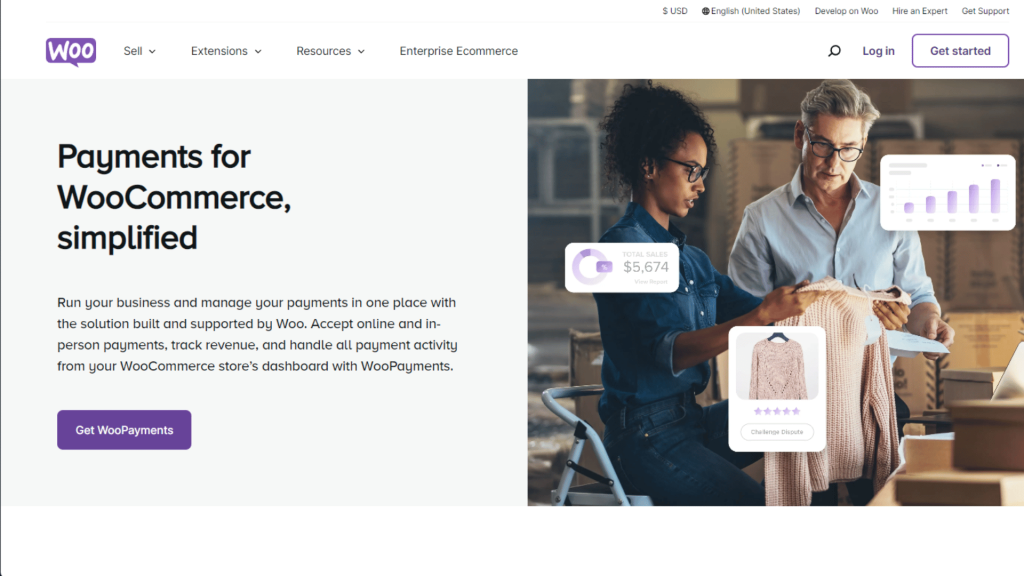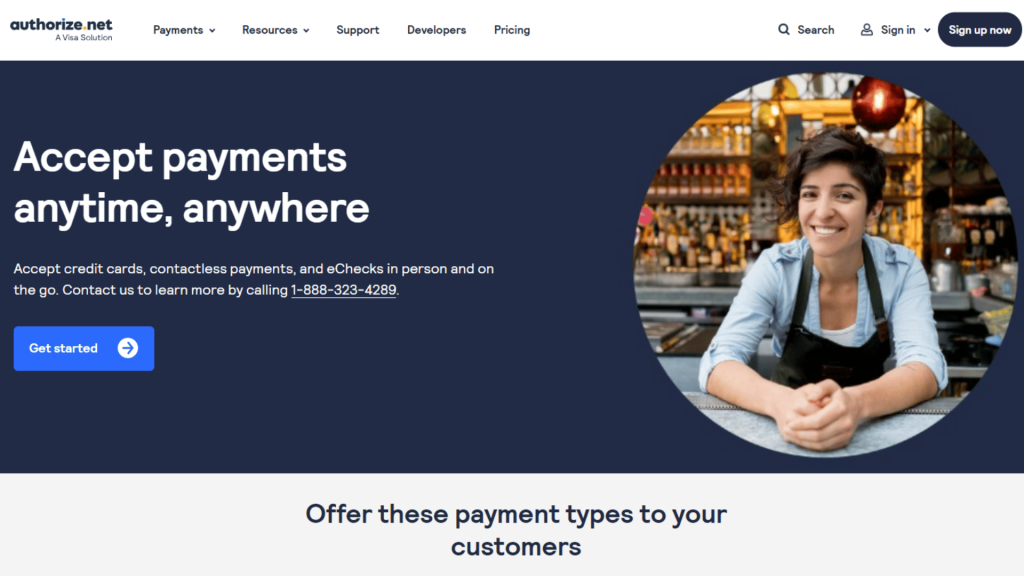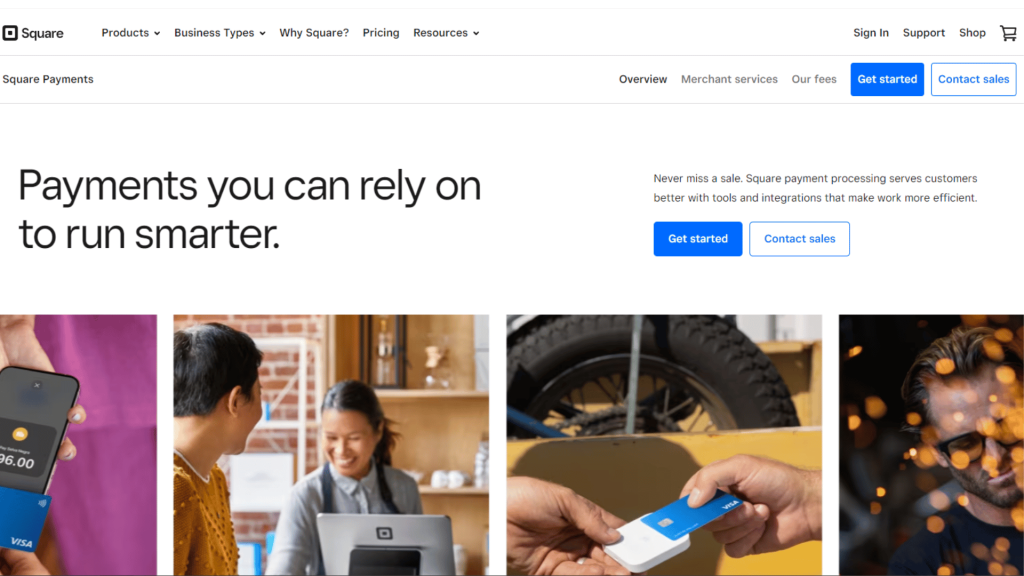Introduction to The Top 5 WooCommerce Payment Gateways
WooCommerce, an open-source ecommerce platform, has revolutionized the way businesses launch and grow their online stores. This blog post will delve into the top 5 WooCommerce payment gateways, the intricacies of payment gateways, focusing on popular options like Stripe, PayPal, Woo Payments, Authorize.Net, and Square, and how they integrate with WooCommerce.
Table of Contents
What Is a Payment Gateway?
A payment gateway is a merchant service provided by an ecommerce application service provider that authorizes credit card or direct payments processing for e-businesses, online retailers, or traditional brick and mortar. It is a crucial component in the electronic payment processing system, as it is the intermediary between a merchant’s website and the financial institutions that process transactions.
How Does a Payment Gateway Work?
When a customer places an order from an online store, the payment gateway performs several tasks to finalize the transaction:
- Encryption: The web browser encrypts the data to be sent between it and the vendor’s web server. The gateway then sends the transaction data to the payment processor used by the vendor’s acquiring bank.
- Authorization Request: The payment processor sends the transaction data to a card association, which routes it to the card-issuing bank for authorization.
- Response: The credit card issuing bank views the transaction and either approves or denies it, then relays the results back to the processor, which passes it back to the gateway.
- Completion: If approved, the merchant fulfills the order, and the bank will transfer the funds. The entire process typically takes just a few seconds.
Integrating Payment Gateways with WooCommerce
WooCommerce supports various payment gateways, providing flexibility and security in transactions. Let’s explore some of the most popular ones:
- Stripe: Known for its simplicity and ease of integration, Stripe offers a seamless payment experience for both merchants and customers. It supports recurring payments and can handle international transactions.
- PayPal: A widely recognized and trusted payment solution, PayPal offers extensive support for international currencies and is known for its robust fraud protection measures.
- WooCommerce Payments: Designed specifically for WooCommerce, Woo Payments offers a streamlined experience, allowing users to manage everything directly from the WooCommerce dashboard.
- Authorize.Net: This gateway is known for its advanced fraud detection services and the ability to handle high-volume transactions, making it ideal for larger businesses.
- Square: Square is particularly beneficial for businesses that operate both online and offline, offering a unified solution for all sales channels.
Stripe
Stripe has emerged as a leading payment processor in the digital age, renowned for its innovative approach to online payment solutions. Catering to a wide range of businesses, from small startups to large enterprises, Stripe simplifies the process of accepting payments online and in mobile apps. Its user-friendly interface, robust security measures, and extensive feature set make it a popular choice among e-commerce platforms and online merchants.

Main Features of Stripe
- Seamless Integration: Stripe offers easy integration with numerous e-commerce platforms and websites. Its well-documented APIs allow developers to customize the payment experience to fit the specific needs of their business.
- Global Reach: Supporting over 135 currencies and payment methods, Stripe enables businesses to accept payments from customers all around the world, making it an ideal solution for global e-commerce.
- Subscription Billing: Stripe’s recurring billing system is a boon for businesses that operate on a subscription model. It automates the billing process, manages subscriptions, and even handles free trials and discounts.
- Advanced Fraud Protection: Stripe uses machine learning algorithms to help detect and prevent fraud, providing businesses with an additional layer of security.
- Reporting and Analytics: The platform offers comprehensive reporting tools that give insights into payment data, helping businesses make informed decisions.
- Customizable Checkout Experience: Stripe provides a customizable checkout experience that can be tailored to match the look and feel of your website, providing a seamless experience for customers.
Pros of Using Stripe
- User-Friendly: Stripe is known for its intuitive user interface, making it easy for non-technical users to navigate.
- Developer-Friendly: With its robust APIs and extensive documentation, Stripe is highly favored by developers for custom integrations.
- Transparent Pricing: Stripe offers clear, straightforward pricing with no hidden fees, which is beneficial for businesses planning their finances.
- Strong Security: Compliance with PCI DSS and the use of advanced encryption methods ensure that Stripe maintains high security standards.
Cons of Using Stripe
- Costs for Additional Services: While Stripe offers competitive basic rates, costs can add up for using additional features and services.
- Limited Offline Use: Stripe is primarily designed for online transactions, which might not be ideal for businesses that also have a significant offline presence.
- Complexity for Beginners: Despite its user-friendly interface, the vast array of features and customization options can be overwhelming for beginners or small businesses without a dedicated tech team.
Supported Payment Methods
Stripe supports a wide range of payment methods to cater to a global audience. These include:
- Credit and Debit Cards: All major credit and debit cards from around the world.
- Bank Transfers: Options like ACH and SEPA for direct bank transfers.
- Wallets: Digital wallets like Apple Pay and Google Pay.
- Local Payment Methods: Country-specific methods like Alipay, WeChat Pay, and others.
To learn more mbout Stripe visit: https://stripe.com/
Paypal
PayPal is one of the most recognized and widely used payment processors globally, known for its ease of use and widespread acceptance. It caters to a diverse range of users, from individual sellers and small businesses to large corporations. PayPal’s appeal lies in its simplicity, security, and flexibility, making it a go-to choice for online transactions, whether for e-commerce, freelancing, or personal use.

Main Features of PayPal
- User-Friendly Interface: PayPal is renowned for its straightforward and intuitive interface, making it easy for users to send and receive payments.
- Wide Acceptance: With millions of users worldwide, PayPal is accepted by a vast number of online merchants, enhancing its utility for users.
- Flexible Payment Options: PayPal allows users to link multiple bank accounts, credit cards, and debit cards to their account, offering flexibility in how they pay or receive money.
- PayPal Business Solutions: For businesses, PayPal offers features like invoicing, payment processing for websites, and the ability to accept various payment types, including credit card payments, both online and in-person.
- Strong Security Measures: PayPal employs robust encryption and fraud prevention technologies, providing a secure environment for online transactions.
- Global Reach: PayPal supports international payments and currency conversions, making it a convenient option for cross-border transactions.
Pros of Using PayPal
- Ease of Use: PayPal’s simple setup and easy-to-navigate interface make it accessible to everyone, regardless of technical expertise.
- Security: With advanced security measures, PayPal offers a safe platform for conducting transactions, which is a significant concern in online dealings.
- Flexibility: The ability to link multiple payment methods and choose preferred ones for different transactions adds to its flexibility.
- Mobile App: PayPal’s mobile app is feature-rich, allowing users to manage transactions, send invoices, and make payments on the go.
- Buyer and Seller Protections: PayPal provides certain protections for both buyers and sellers, helping to ensure that transactions are fair and secure.
Cons of Using PayPal
- Fees: PayPal’s fee structure, especially for international transactions and currency conversions, can be a downside for users.
- Account Limitations: PayPal is known to freeze accounts or hold funds for various reasons, which can be a significant inconvenience for users.
- Dispute Resolution: While PayPal offers dispute resolution services, the process can be lengthy and sometimes unsatisfactory for both parties involved.
- Less Suitable for High-Volume Merchants: For businesses with a high volume of transactions, the fees and certain limitations of PayPal might not be the most economical choice.
Supported Payment Methods
PayPal supports a variety of payment methods, catering to a broad user base. These include:
- Credit and Debit Cards: Major credit and debit cards are accepted globally.
- Bank Accounts: Users can link their bank accounts for direct withdrawals and deposits.
- PayPal Balance: Users can maintain and use a balance in their PayPal account.
- PayPal Credit: Offers credit options to users, subject to approval.
- Mobile Payments: Integration with mobile wallets and NFC payments in some regions.
PayPal Conclusion
PayPal remains a dominant force in the online payment processing world due to its user-friendly nature, security, and widespread acceptance. Its versatility makes it suitable for a variety of users, from individuals to businesses. However, considerations around fees, account limitations, and suitability for high-volume merchants are important factors to consider. Overall, PayPal’s reputation, ease of use, and robust security features continue to make it a preferred choice for online transactions worldwide.
To learn more about Paypal visit: https://paypal.com
WooCommerce Payments
Woo Payments, specifically designed for WooCommerce, is a streamlined payment solution that integrates seamlessly with WooCommerce stores. It’s tailored to enhance the e-commerce experience for both store owners and customers by simplifying the payment process. This platform is particularly appealing to those already using or planning to use WooCommerce for their online store.

Main Features of Woo Payments
- Native Integration with WooCommerce: Woo Payments is built to work natively with WooCommerce, ensuring a smooth and cohesive user experience without the need for additional integration.
- Simplified Management: Store owners can manage payments, refunds, and other transaction details directly from their WooCommerce dashboard, offering convenience and efficiency.
- Secure Transactions: Security is a top priority, with Woo Payments providing safe and reliable transaction processing, adhering to industry standards.
- Subscription Payments: It supports WooCommerce Subscriptions, allowing businesses to easily set up and manage recurring payments.
- Multi-Currency Support: Woo Payments enables transactions in multiple currencies, making it a suitable option for stores with an international customer base.
- Transparent Pricing: The pricing structure is straightforward, with clear transaction fees and no hidden costs, which is beneficial for budgeting and financial planning.
Pros of Using Woo Payments
- Seamless Integration: Being a native WooCommerce solution, it offers a seamless integration, providing a consistent and efficient experience for both store owners and customers.
- Ease of Use: The ability to manage everything within the WooCommerce dashboard simplifies the payment process for store owners.
- Designed for WooCommerce: As it’s built specifically for WooCommerce, it aligns perfectly with all WooCommerce features and extensions.
- No Setup or Monthly Fees: Woo Payments typically doesn’t charge setup or monthly fees, making it cost-effective for small to medium-sized businesses.
- Customer Support: Direct support from the WooCommerce team ensures that any issues related to payments are promptly addressed.
Cons of Using Woo Payments
- Limited to WooCommerce: Its exclusive design for WooCommerce means it’s not an option for websites using other e-commerce platforms.
- Geographical Availability: Woo Payments may not be available in all countries, which could be a limitation for some businesses.
- Potentially Higher Transaction Fees: Depending on the transaction volume and type, the fees might be higher compared to some other payment gateways.
- Less Flexibility: Being tied to WooCommerce, it offers less flexibility for customization outside the WooCommerce ecosystem.
Supported Payment Methods
Woo Payments supports a range of payment methods, catering to the diverse needs of WooCommerce users. These include:
- Credit and Debit Cards: Major credit and debit cards are accepted.
- Bank Transfers and Direct Debit: In some regions, it supports bank transfers and direct debit options.
- Digital Wallets: Integration with digital wallets like Apple Pay and Google Pay is available, enhancing the checkout experience for mobile users.
Woo Payments Conclusion
Woo Payments is an excellent choice for those who have built their online stores on WooCommerce and are looking for a payment solution that offers native integration, ease of use, and direct support from the WooCommerce team. While it may not be the most flexible or cost-effective solution for all businesses, especially those operating outside the WooCommerce ecosystem, its streamlined approach and specific design for WooCommerce make it a compelling option for many e-commerce store owners.
To learn more about WooCommerce Payments visit: https://woo.com/payments/
Authorize.Net
Authorize.Net, a subsidiary of Visa, is a well-established payment gateway service provider that has been facilitating online payments for businesses of various sizes since 1996. Known for its reliability and versatility, Authorize.Net is a popular choice among merchants who require a robust, secure, and flexible payment processing solution.

Main Features of Authorize.Net
- Versatile Payment Gateway: Authorize.Net supports a wide range of payment types, including credit card processing, electronic checks, and digital payments.
- Advanced Fraud Detection Suite (AFDS): This feature provides tools to help merchants prevent fraudulent transactions, enhancing security for both the business and its customers.
- Recurring Billing: Ideal for subscription-based services, Authorize.Net offers automated recurring billing, which is a crucial feature for businesses that operate on a membership or subscription model.
- Customer Information Manager (CIM): This allows for secure storage of customer payment information, enabling repeat customers to checkout faster and more securely.
- Simple Checkout Options: Authorize.Net provides a simple, customizable API for integration with websites, as well as a hosted payment page for merchants who prefer not to handle sensitive payment data directly.
- Mobile Payments: The platform is equipped to handle mobile payments, making it a versatile option for businesses with a mobile presence.
Pros of Using Authorize.Net
- Strong Security: With advanced fraud detection and secure customer data management, Authorize.Net is known for its high security standards.
- Flexibility in Integration: Its API allows for easy integration with numerous e-commerce platforms and custom-built websites.
- Reputation and Reliability: Being in the industry for over two decades, Authorize.Net has built a reputation for reliability and trustworthiness.
- Support for Various Payment Types: It supports a wide range of payment methods, catering to a diverse customer base.
- Detailed Reporting: Authorize.Net provides comprehensive transaction reports, which are crucial for financial tracking and analysis.
Cons of Using Authorize.Net
- Fees: Authorize.Net charges a monthly gateway fee, transaction fees, and potentially other additional fees, which might be a consideration for small businesses or startups.
- Complexity for Beginners: The platform’s wide array of features and settings can be overwhelming for new users or small businesses without a dedicated technical team.
- Limited Global Reach: While it supports some international transactions, Authorize.Net is primarily focused on the United States, which might be a limitation for global e-commerce businesses.
- Separate Merchant Account Required: Unlike all-in-one solutions, Authorize.Net requires merchants to have a separate merchant account, which can be an additional step in the setup process.
Supported Payment Methods
Authorize.Net supports a variety of payment methods, which include:
- Credit and Debit Cards: All major credit and debit cards.
- Electronic Checks: Via its eCheck.Net service.
- Digital Payment Solutions: Such as Apple Pay, PayPal, and Visa Checkout.
Authorize.net Conclusion
Authorize.Net stands out as a comprehensive and secure payment gateway solution, particularly suited for businesses looking for a reliable and versatile payment processing system. Its advanced security features and robust support for various payment types make it a strong contender in the market. However, the additional costs and complexity might be a deterrent for smaller businesses or those just starting out. For businesses with the capacity to manage a separate merchant account and navigate its extensive features, Authorize.Net offers a solid, professional payment processing service.
To learn more about Authorize.net visit: https://www.authorize.net/
Square
Square, Inc. is a financial services and mobile payment company that has significantly impacted how small businesses process transactions. Known for its compact card reader and comprehensive point-of-sale (POS) system, Square has expanded its services to include a robust online payment platform. It’s particularly favored by small to medium-sized businesses for its simplicity, transparency, and no-frills approach to payment processing.

Main Features of Square
- Integrated Payment System: Square offers an all-in-one payment solution, combining in-person, mobile, and online payments, which is ideal for businesses with both physical and online sales channels.
- Point of Sale (POS) Software and Hardware: Square provides intuitive POS software and hardware, making it easy for businesses to process sales, manage inventory, and track customer data.
- No Monthly Fees: One of Square’s main attractions is its straightforward pricing with no monthly fees, making it accessible for small businesses and startups.
- Square Online Store: Businesses can create an online store directly through Square, which seamlessly integrates with its payment processing system.
- Invoicing and Virtual Terminal: Square allows businesses to send invoices and accept payments over the phone or via mail through its virtual terminal feature.
- Data Analytics and Reporting: The platform offers comprehensive analytics and reporting tools, giving businesses insights into sales trends and customer behavior.
Pros of Using Square
- Ease of Use: Square is known for its user-friendly interface, making it easy for businesses to set up and start processing payments quickly.
- All-in-One Platform: With tools for both physical and online sales, Square is a versatile choice for businesses that operate in multiple channels.
- Transparent Pricing: Square’s clear, flat-rate pricing structure is a major plus, especially for small businesses mindful of budget constraints.
- No Long-Term Contracts: The service operates on a pay-as-you-go basis, which means businesses aren’t locked into long-term contracts.
- Strong Offline Presence: Square excels in in-person payment processing, making it ideal for retail stores, restaurants, and other brick-and-mortar businesses.
Cons of Using Square
- Higher Fees for Certain Transactions: While Square offers flat-rate pricing, the fees can be higher for keyed-in transactions, which might affect businesses with a high volume of such transactions.
- Account Stability Issues: Some users report issues with account stability, such as holds on funds or account terminations, which can be disruptive for businesses.
- Limited International Use: Square’s services are primarily focused on the US, Canada, Japan, Australia, and the UK, which may limit its utility for global businesses.
- Basic Features for Large Businesses: Larger businesses might find Square’s features somewhat basic compared to more complex enterprise solutions.
Supported Payment Methods
Square supports a range of payment methods to accommodate various customer preferences:
- Credit and Debit Cards: Accepts all major credit and debit cards.
- Contactless Payments: Includes NFC payments like Apple Pay and Google Pay.
- Gift Cards: Offers the option to accept Square gift cards.
- Online and Mobile Payments: Through Square’s online store or integrated e-commerce platforms.
Square Conclusion
Square is a strong contender in the payment processing arena, especially for small to medium-sized businesses seeking a straightforward, all-in-one payment solution. Its user-friendly system, transparent pricing, and versatility in handling both in-person and online transactions make it a popular choice. While it may not be the most cost-effective for businesses with a high volume of non-swipe transactions or those operating on a global scale, Square’s comprehensive suite of services offers a solid foundation for businesses looking to streamline their payment processes.
To learn more about square visit: https://squareup.com/
Transaction Fee Table
Payment gateway transaction fees are charges imposed on businesses or individuals for the use of a payment gateway service, which enables online transactions, such as credit card payments, to be securely processed over the internet. These fees typically consist of two main components: a flat fee and a percentage fee.
The flat fee is a fixed amount that is charged for each transaction, regardless of the transaction amount. This fee covers the basic cost of processing the payment and maintaining the security of the gateway. It ensures that the payment gateway provider can cover their operational expenses.
The percentage fee, on the other hand, is a percentage of the total transaction amount. This fee is calculated based on the transaction’s value, meaning that the higher the transaction amount, the higher the percentage fee. The percentage fee is typically higher than the flat fee and is a way for payment gateway providers to generate additional revenue based on the volume and value of transactions being processed.
In addition to these two primary fees, there may be other charges or fees associated with payment gateway services, such as monthly subscription fees, setup fees, or chargeback fees. It’s important for businesses to carefully review the fee structure of their chosen payment gateway provider to understand the cost implications and make informed decisions about which provider best suits their needs.
| Payment Gateway | Transaction Fee (Base + Percentage) |
|---|---|
| Stripe | $0.30 + 2.9% |
| Paypal | $0.49 + 3.49% |
| WooCommerce Payments | $0.30 + 2.9% |
| Authorize.net | $0.30 + 2.9% |
| Square | $0.30 + 2.9% |
Conclusion
In the dynamic world of e-commerce, selecting the right payment gateway is not just a matter of transaction processing, but a crucial decision that impacts customer experience, operational efficiency, and ultimately, the success of your online store. Our comprehensive review of the top 5 WooCommerce payment gateways – Stripe, PayPal, Woo Payments, Authorize.Net, and Square – provides a clear insight into the unique features, advantages, and limitations of each, helping you make an informed choice tailored to your business needs.
Each of these gateways offers distinct functionalities: Stripe’s developer-friendly interface, PayPal’s global recognition, Woo Payments’ seamless integration with WooCommerce, Authorize.Net’s robust security features, and Square’s all-in-one payment solution. The decision hinges on various factors including transaction fees, security measures, user experience, and compatibility with your business model.
Remember, the ideal payment gateway not only processes transactions but also enhances customer trust, ensures data security, and aligns with your business growth. As e-commerce continues to evolve, staying informed and adaptable to changing payment technologies will be key to maintaining a competitive edge.
We hope this analysis assists you in navigating the complexities of e-commerce payment solutions. Should you require further guidance or support in optimizing your WooCommerce store, feel free to reach out to us at 17 Solutions. Our expertise in e-commerce solutions is geared towards empowering your business in the digital marketplace. Explore WooCommerce further and embark on a journey to e-commerce success with the right payment gateway as your ally.
Contact Us To Learn More